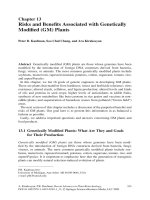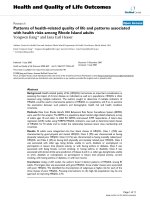Risks and Benefits Associated with Genetically Modified (GM) Plants
Bạn đang xem bản rút gọn của tài liệu. Xem và tải ngay bản đầy đủ của tài liệu tại đây (200.28 KB, 14 trang )
Chapter 13
Risks and Benefits Associated with Genetically
Modified (GM) Plants
Peter B. Kaufman, Soo Chul Chang, and Ara Kirakosyan
Abstract Genetically modified (GM) plants are those whose genomes have been
modified by the introduction of foreign DNA constructs derived from bacteria,
fungi, viruses, or animals. The most common genetically modified plants include
soybeans, maize/corn, rapeseed mustard, potatoes, cotton, sugarcane, tomato, rice,
and aspen/Populus.
In this chapter, we list 16 goals of genetic engineers in developing GM plants.
These are plants that manifest frost hardiness; insect and herbicide tolerance; virus
resistance; altered starch, cellulose, and lignin production; altered levels and kinds
of oils and proteins in seed crops; higher levels of antioxidants in edible fruits,
synthesis of new metabolites like beta-carotene in rice grains and vaccines in non-
edible plants; and sequestration of hazardous wastes from polluted (“brown field”)
areas.
The next section of this chapter includes a discussion of the purported benefits and
risks of GM plants. Our goal here is to present this information in as balanced a
fashion as possible.
Lastly, we address important questions and answers concerning GM plants and
food products.
13.1 Genetically Modified Plants: What Are They and Goals
for Their Production
Genetically modified (GM) plants are those whose genomes have been modi-
fied by the introduction of foreign DNA constructs derived from bacteria, fungi,
viruses, or animals. The most common genetically modified plants include soy-
beans, maize/corn, rapeseed mustard, potatoes, cotton, sugarcane, tomato, rice, and
aspen/Populus. It is important to emphasize here that the generation of transgenic
plants can modify natural selection-induced evolution of plants.
P.B. Kaufman (
B
)
University of Michigan, Ann Arbor MI 48109-0646, USA
e-mail:
333
A. Kirakosyan, P.B. Kaufman, Recent Advances in Plant Biotechnology,
DOI 10.1007/978-1-4419-0194-1_13,
C
Springer Science+Business Media, LLC 2009
334 P.B. Kaufman et al.
The goals of genetic engineers in developing genetically modified plants include
the following:
• To develop herbicide-resistant crop plants such as “Roundup Ready”/glyphosate-
resistant soybeans with a gene derived from bacteria.
• To develop insect-resistant crop plants such Bt (Bacillus thuringinensis or
milky spore bacterium) cotton (to kill the cotton boll weevil), potatoes (to
kill the Colorado potato beetle), and corn/maize (to kill the corn ear worm).
Bt-containing plants can cause emergence of Bt-resistant insects. In “Botany
of Desire” by Machael Pollan, he reports that Monsanto Company designed a
method to avoid this. They suggest that farmers allot a part of a field for wild-
type plants, while most of the field is used for Bt-containing transgenic plants.
This strategy can cause wild-type insects to outcompete Bt-resistant mutant
insects.
• To develop viral disease-resistant plants such as papaya and squash that have
virus coat protein gene inserted into their genomes. The virus coat protein gene
that is inserted into these plants prevents the virus from reproducing because it
cannot make coat protein. The mechanism here is called co-suppression.
• To develop plants with enhanced levels of an essential vitamin such as “golden
rice” that produces significant amounts of B-carotene/vitamin A in the grains
based on the introduction of two foreign genes from daffodil and one from a
bacterium. “Golden rice” – enrichment with carotenoids (provitamin A): This
project produced a rice cultivar with enhanced levels of beta-carotene and other
carotenoids, which are metabolic precursors of vitamin A. Vitamin A can be
absorbed with fat by the human body. Because rice naturally contains only
a negligible amount of beta-carotene, vitamin A deficiency is widespread in
regions of the world where rice is a staple food. “Golden rice” was devel-
oped for people of underdeveloped countries. However, the primary drawback
here is that people who live in underdeveloped countries do not have chance
to have such well-nourished foods such as “golden rice” primarily due to its
high cost.
• To develop plants with enhanced frost resistance, GM-frost resistance has been
achieved by research scientists (Professor German Spangenberg and Dr Ulrik
John of the Victorian AgriBiosciences Centre at La Trobe University) in Vic-
toria, Australia, through the use of a gene sequence from Antarctic hairgrass
(Deschampsia antarctica, Poaceae,tribeAveneae (Oats)). The same degree of
frost tolerance is achieved in cereals and grasses. Frost tolerance is activated by
a protective protein that is activated once the temperature drops below 5
◦
C, and
the plant then has the ability to inhibit ice crystal growth which gives the plant its
freezing tolerance.
• To develop plants with altered composition of sugars or starch. GM potato
plants (EH 92-527-1) have been engineered to have tubers with a higher ratio
of branched starch (amylopectin) to straight-chain starch (amylose). These plants
have not been approved for human consumption and were developed primarily
13 Risks and Benefits Associated with GM Plants 335
for production of starch for industrial purposes. Overexpression of the sucrose-
6-phosphate synthase (SPS) gene from maize in tomato, and the same gene from
spinach in tobacco and potato, led to significant increases in sucrose biosynthesis
in the transgenic plants (see Chapter 4).
• To develop tree crops with altered composition of lignin and cellulose in their
wood (xylem) tissues through alterations in lignin biosynthesis (e.g., reduction,
augmentation and/or structural changes) and cellulose biosynthesis (e.g., aug-
mentation, reduction, and/or quality including high degree of polymerization and
crystallinity).
• To develop crop plants whose fruits have longer shelf life due to decreased
action of cell wall hydrolases such as cellulases and polygalacturonases (pecti-
nases). The FlavrSavr
tomato is the most famous example. These tomatoes
were the first GM fruit sold in the United States and were sold as tomato purée
in the UK. Apples, raspberries, and melons with delayed ripening have also been
developed.
• To develop seeds with “Terminator” or other sterilizing traits in crops and orna-
mentals so as to prevent collection of seeds of these plants and thus protect the
interests of the owners of patents for such seeds.
• To develop plants with modified oil content and composition (e.g., polyunsat-
urated fatty acids such as linoleic acid and laureic acid) for maize, soybeans,
rapeseed, and other oil crops: These modified crops could be important in the
fight against cardiovascular disease, obesity, and certain forms of cancer.
• To develop plants with higher content of protein or amino acids, or modified
amino acid composition for enhanced nutritional value: For example, a GM
potato was developed in India containing more than one-third of protein includ-
ing essential, high-quality nutrients. The novel gene came from the protein-rich
grain amaranth plant. Another example is LY038, a maize line with enhanced
lysine content for improved animal feed quality. It is now awaiting authorization
in the EU.
• To develop gluten-free wheat: Celiac sprue patients cannot tolerate the protein
gluten (something similar to an allergy).
• To develop higher levels of beneficial antioxidant compounds (e.g., lycopene,
flavinols found in tomato) to prevent cardiovascular diseases and certain forms
of cancer.
• To eliminate or reduce undesirable substances like allergens or toxic substances
(e.g., caffeine, nicotine).
• To develop transgenic “amylopectin potato” that contains almost exclusively
amylopectin (an increase from 75 to 98%) rather than a mix of different starches
(amylose and amylopectin). This starch will be used for paper, textiles, and
adhesives.
• To develop GM rapeseed oil with high erucic acid content. This oil is used in
plastics and in high-grade industrial lubricants.
• To develop plants with higher carbon fixation rates via photosynthesis.
• To introduce into C-3 plants C-4 photosynthesis capabilities.
336 P.B. Kaufman et al.
13.2 Benefits and Risks of Genetically Modified Plants
A number of positive and negative issues are associated with plant biotechnology
and its applications (Ellstrand, 2000; Gadgil, 2000). The positive issues concern
the major benefits that plant biotechnology may contribute to industry, agriculture,
and the environment. One of the significant issues is concerned with economically
feasible production of crops, pharmaceuticals, and other industrial products (Arber,
2009). We are able to grow more tolerant crops with new traits or produce important
vaccines using plant cell factories. Other positive impacts on the environment may
involve clearance of contaminated soil by means of phytoremediation as described
in Chapter 7. Plants have been found to break down or degrade organic contami-
nants (similar to microbes), while others are able to extract and stabilize toxic metal
contaminants by acting as traps or filters.
Scientists engaged in plant biotechnology should follow all regulatory mandates
as well as socially and ethically acceptable targets (Boulter, 1995). Thus, the risks
must be evaluated in connection with workplace safety, environmental contamina-
tion, and public exposure. In conducting risk assessments, it is important to consider
all normal and foreseeable abnormal operations, maintenance, cleaning, and secu-
rity. Following completion of a risk assessment and risk characterization, devel-
opment of effective risk management programs, such as implementation through
training and selection of risk management tools, is needed.
The criteria for risk assessment are based on both genetically modified and orig-
inal unmodified plants, their potential environmental interactions, as well as the
possible effects of plants or their products on the human health (Magaña-Gómez
and de la Barca, 2009). Characterization of the novel trait plays a central role in
the assessment process and overlaps the assessment of the modified plant. The main
criteria assigned pertain to information about the genetic construct (inserted genes,
regulatory mechanisms, marker genes, and donors or recipients), the gene func-
tions, complementary and breakdown products, affected metabolic pathways, and
potential toxic and allergic effects of the plant product(s). Thus, the negative issues
relative to plant biotechnology include potential harm to non-target organisms or
potential introduction of regulatory molecules (such as transcriptional factors or hor-
mones) into the same organism with subsequent effects on other genes. The main
issue associated with gene biotechnology is that the foreign genes could escape into
nature and this process could be uncontrolled. This can lead to loss of biodiversity
or to the derivation of new plant organisms with unpredicted properties. The other
most serious concern is that pollen from genetically engineered plants could con-
taminate natural populations due to pollination. In order to escape such difficulties,
foreign gene(s) may be transferred to the special organelles, such as chloroplasts
or mitochondria, for gene function and possible application, and therefore, the risk
assessment with pollination is kept to the minimum.
With the entry of genetically modified (GM) crops into our food chain, con-
sumers are demanding both satisfactory information and choice about GM crops
(Parker and Kareiva, 1996; Krebs, 2000; Pimentel et al., 2000). To satisfy this
demand, many countries are introducing legislation to control the circulation of GM
13 Risks and Benefits Associated with GM Plants 337
crops or to trace the use of approved GM crops. GM plants must go through a rigor-
ous stepwise screening process involving both confined and unconfined field trails.
In general, plants with novel traits are regulated on the basis of the characteristics
of the product, not the specific process by which the product is made. More specif-
ically, when the next novel plant is assessed, emphasis is placed on the insertion of
the novel gene(s) into the plant genome; the number of sites of integration (loci); the
copy numbers; presence of rearrangements; the stability; the expression; alterations
of metabolic pathways; the activity of an inserted gene product in the plant; and the
activity of the gene product in the environment. Potential altered interactions of the
novel plants involve identifying changes to the relative phenotype with respect to
stress adaptation, composition, toxins, and agronomic characteristics.
A list of potential ecological benefits (Daily, 1999; Dyson, 1999) and risks of
selected GM crops is presented in Table 13.1. It provides a framework that makes
Table 13.1 Examples of the potential ecological benefits and risks of selected GM crops
GM modification Benefits Risks
Herbicide resistance in
crops
Reduced herbicide use
Increased opportunities for
reduced tillage systems
Increased herbicide use
Reduced in-field biodiversity
that may reduce the ecological
services provided by
agricultural ecosystems
Crops with Bt toxin Reduced pesticide use
Kills fewer non-target
organisms than alternatives
such as broad-spectrum
pesticides
Promotes development of Bt
resistance, which will eliminate
Bt as a relatively safe pesticide
Kills non-target caterpillars and
butterflies such as monarchs
(Pimentel 2000)
Virus resistance in
small grains due to
coat proteins
Reduced insecticide use to
control insect dispersers of
pathogens (Hails 2000)
Facilitates the creation of new
viruses (Hails 2000)
Moves genes into
nonagricultural ecosystems
where the subsequent increase
in fitness of weedy species could
eliminate endangered species
Terminator or other
sterilizing traits in
crops and
ornamentals
Prevents the movement of traits
to non-target species
Prevents the movement of
introduced species to other
ecosystems (Walker and
Lonsdale 2000)
Prevents farmers from developing
their own seed supplies adapted
to local conditions (Conway
2000)
Synthesis of vitamin A
or other nutrients
Improves nutrition of people
who depend heavily on rice
(Conway 2000)
Disrupts local ecosystems if an
ecologically limiting nutrient or
protein is produced
Nitrogen fixation by
non-legumes
Reduces energy used in
fertilizer production and
application (Pimentel 2000)
Adds to excess nitrogen leaching
from agricultural activities,
degrading human health and
reducing biodiversity









